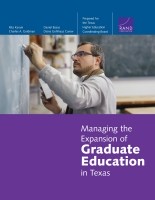| 来源类型 | Research Reports
|
| 规范类型 | 报告
|
| DOI | https://doi.org/10.7249/RR1899
|
| ISBN | 9780833097446
|
| 来源ID | RR-1899-CFAT
|
| Managing the Expansion of Graduate Education in Texas |
| Rita Karam; Charles A. Goldman; Daniel Basco; Diana Gehlhaus Carew
|
| 发表日期 | 2017
|
| 出版年 | 2017
|
| 页码 | 92
|
| 语种 | 英语
|
| 结论 |
Labor Market Demand for Graduate Degrees- We examined labor market demand by estimating which occupations in Texas will likely see the largest increase in new jobs requiring a graduate degree over the next few years. Across the top occupations for graduate demand, we estimate more than 120,000 new jobs requiring graduate education will be created in Texas between 2012 and 2022. Business, healthcare, and teachers are the occupational groups with greatest demand.
Graduate Degree Production- Texas has been increasing production of graduate degrees, especially in business and health fields, although engineering production has not grown much.
- Texas has a large, diverse population, and its Hispanic population is growing particularly rapidly but is not well represented in graduate education.
Texas's Position in Graduate Education and Research- We compared Texas with three other large states: California, Florida, and New York. Adjusted for population, Texas's graduate degree production is comparable with California's, above Florida's and below New York's.
- Adjusted for population, Texas received about 49 percent of California's federal research and development funding level and 44 percent of New York's level.
- The number of research universities in Texas is increasing rapidly compared with other states, but few of these institutions are ranked at the highest levels internationally.
Institutional Motivation to Offer Graduate Degrees- Institutions and departments vary in their motivations to offer graduate degrees. Some motivators are concerned with institutional prestige relative to other institutions, while some are closer to the departmental level, such as responding to student or labor market demand or new requirements from professional organizations.
|
| 摘要 |
- To enhance the competitiveness of Texas public higher education institutions, THECB should continue, and consider increasing, state research program funding.
- Consider increases in general fund appropriations to support growing enrollments, and use the current formula funding method to allocate them.
- Institutions and systems should consider programs to strengthen the pipeline of domestic students, including underrepresented minorities, into science and engineering graduate programs.
- The state (or other funders) should consider funding special stipends for domestic students in science and engineering doctoral programs.
- Place more emphasis on institutional support and policies in reviewing doctoral program proposals.
- Review student access regularly and consider alternative pathways when needed.
- Ensure the quality of master's programs through accreditation or an alternative process.
- Support institutional access to labor market analysis tools.
- Require institutions to demonstrate a need for multidisciplinary programs.
- Institutions should conduct their own preproposal reviews.
- Institutions should consult informally with THECB staff early during proposal development.
|
| 主题 | Education Policy
; Labor Markets
; Postsecondary Education
; Texas
; Workforce Development
; Workforce Management
|
| URL | https://www.rand.org/pubs/research_reports/RR1899.html
|
| 来源智库 | RAND Corporation (United States)
|
| 引用统计 |
|
| 资源类型 | 智库出版物
|
| 条目标识符 | http://119.78.100.153/handle/2XGU8XDN/108476
|
推荐引用方式
GB/T 7714 |
Rita Karam,Charles A. Goldman,Daniel Basco,et al. Managing the Expansion of Graduate Education in Texas. 2017.
|
|
文件名:
|
x1495302407023.jpg
|
|
格式:
|
JPEG
|

|
文件名:
|
RAND_RR1899.pdf
|
|
格式:
|
Adobe PDF
|
除非特别说明,本系统中所有内容都受版权保护,并保留所有权利。